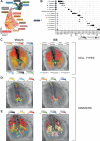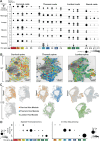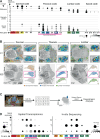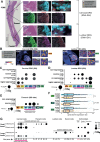HOX gene expression in the developing human spine
- PMID: 39567486
- PMCID: PMC11579336
- DOI: 10.1038/s41467-024-54187-0
HOX gene expression in the developing human spine
Abstract
Positional coding along the anterior-posterior axis is regulated by HOX genes, whose 3' to 5' expression correlates with location along this axis. The precise utilisation of HOX genes in different human cell types is not fully understood. Here, we use single-cell and spatial-transcriptomics, along with in-situ sequencing, to create a developmental atlas of the human fetal spine. We analyse HOX gene expression across cell types during development, finding that neural-crest derivatives unexpectedly retain the anatomical HOX code of their origin while also adopting the code of their destination. This trend is confirmed across multiple organs. In the axial plane of the spinal cord, we find distinct patterns in the ventral and dorsal domains, providing insights into motor pool organisation and loss of collinearity in HOXB genes. Our findings shed new light on HOX gene expression in the developing spine, highlighting a HOX gene 'source code' in neural-crest cell derivatives.
© 2024. The Author(s).
Conflict of interest statement
Competing interests: The authors declare no competing interests.
Figures








References
-
- Sheng, G., Martinez, A. A. & Sutherland, A. The primitive streak and cellular principles of building an amniote body through gastrulation. Science374, abg1727 (2021). - PubMed
-
- Lewis, E. B. A gene complex controlling segmentation in Drosophila. Nature276, 565–570 (1978). - PubMed
-
- Harding, K., Wedeen, C., McGinnis, W. & Levine, M. Spatially regulated expression of homeotic genes in Drosophila. Science229, 1236–1242 (1985). - PubMed
-
- Soshnikova, N. & Duboule, D. Epigenetic temporal control of mouse Hox genes in vivo. Science324, 1320–1323 (2009). - PubMed
Publication types
MeSH terms
Substances
Grants and funding
LinkOut - more resources
Full Text Sources

